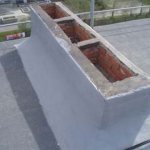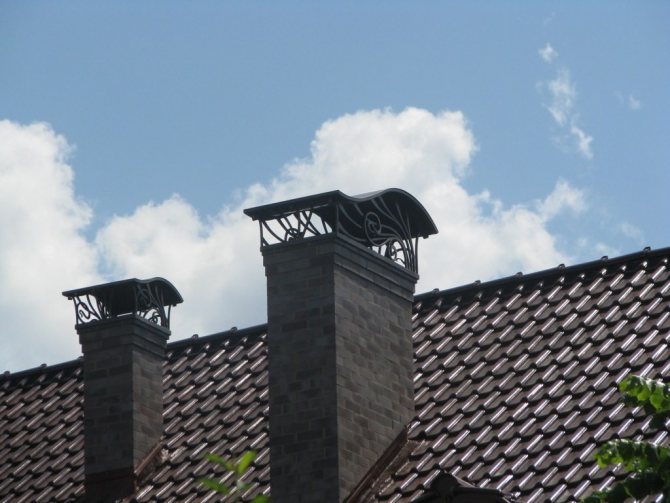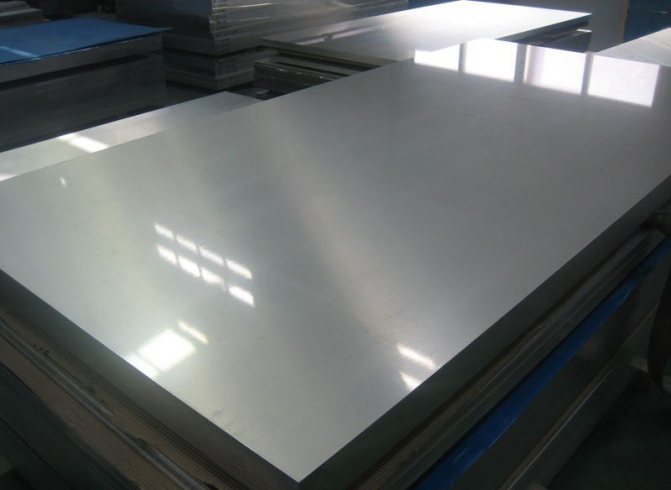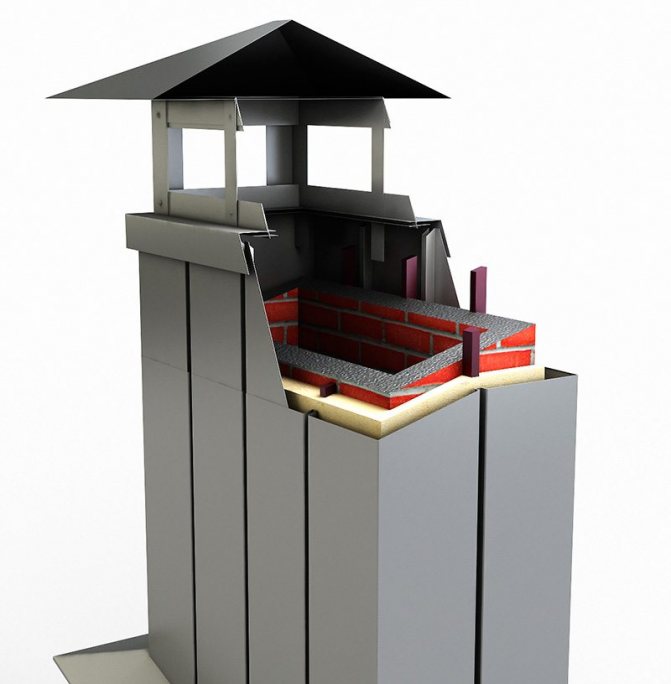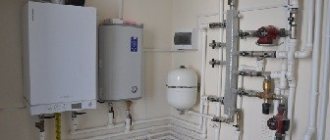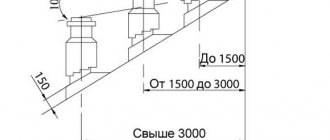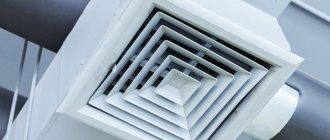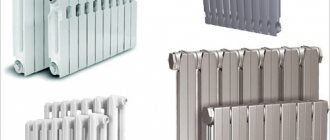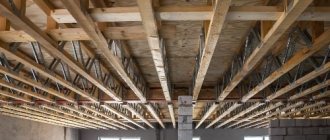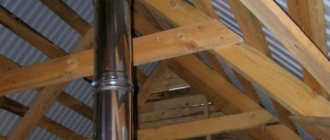The guarantee that a pleasant microclimate for life will always remain in the new house is the arrangement of a high-quality air circulation system. Well, in order for such communication to function efficiently and effectively, it is necessary to correctly calculate the required length and diameter of the duct.
In order to make a calculation, you need to be familiar with the requirements for the system, and use one of the developed calculation methods.
Consequences of poor-quality ventilation
The following factors can become the consequences of an illiterately created duct network:
- Lack of oxygen in the room;
- High humidity level;
- The appearance of soot on the walls of the kitchen;
- Misting windows in the room;
- The appearance of fungus on the surface of the walls.
In order to build a system for the outflow of air masses with your own hands, products of two types of section can be used:
- Square - are installed in forced-type structures using specialized devices;
- Round - are used for the installation of simple systems and are the most durable, sealed products with excellent aerodynamic performance.
Calculation of basic parameters
Standard volume of inflow
Determination of the supply air volume is carried out in accordance with the requirements of regulatory documents and the rate of exchange rate.
Also, the volume is determined depending on the type of room and its purpose:
- Residential buildings - 20 cubic meters m / hour (temporary location), 60 cu. m / hour (permanent location);
- Ancillary structures - 180 cubic meters m / hour.
Air duct diameter
To determine the diameters of the elements of a system with a natural inflow without installing equipment for forced circulation of flows, calculations are carried out based on the following indicators:
- Section of the ventilation outlet opening;
- Room area.
More accurate figures are obtained through complex calculations.
Features of determining the length
The most important parameter for such communication is the height of the ventilation pipe above the roof. It is she who unites the ventilation ducts of the whole house and serves as the outlet of air to the environment.
Calculations according to the table
The height of the ventilation pipe above the roof according to SNIP is in direct proportion to its diameter, and it can be determined using the presented table.
When using this table, the following points should be taken into account:
- The height of the chimney above the roof and the ventilation must be the same if they are located close to each other... This is necessary in order to exclude the ingress of smoke into the dwelling through the air ducts during the heating season;
- The height of the pipe above the roof ridge should exceed it by 0.5 meters if it is located at a distance of no more than 1.5 m from it;
Note! The same rule applies if the terminal is located at a distance of no more than 1.5 m from the parapet.
- The outlet can be below the level of the ridge if it is located at a distance of 1.5-3 m from it;
- If the installation is carried out on a flat floor, then the minimum height should be 50 cm.
Advice. When choosing both the pipe itself and the place of its output to the roof surface, it is necessary to provide for a sufficient level of resistance to air flows. The material must withstand a load of 40-60 kilograms per square meter. surface, such a load is comparable to a storm of 10 points.
Application of software
All the calculations necessary for the competent organization of ventilation in the home are quite complex and time-consuming, therefore specialized programs have been developed that will calculate everything for you.
To begin with, the instruction stipulates the need to calculate the optimal volume of inflow, based on the purpose of the room. After that, depending on the parameters of the projected communication and the obtained figures, the parameters of the duct are calculated.
The software performs all operations, relying also on the following parameters:
- Indicators of the average temperature inside and outside the premises;
- Geometric parameters;
- Roughness index inside the structure, which directly depends on the type of material;
- Resistance to displacement of air masses.
The result of the program will be accurate calculated data on the diameter of the duct pipe, which will ensure air circulation in the dwelling.
Advice. When making calculations, it is necessary not to lose sight of such a parameter as local circulation resistance. Such resistance can be caused by the presence of grids, grilles, bends and other devices at the ventilation outlet.
Ventilation shaft device ↑
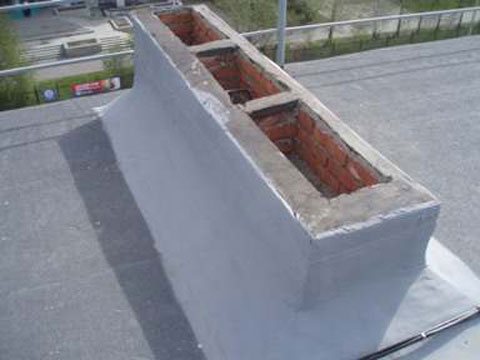
The structure, as a rule, looks like a cylindrical barrel. It is located strictly vertically and contains three parts:
- one large - about 300x600 mm;
- two small ones - about 150 mm.
It is the large part that is the trunk that crosses all the floors of the building, from the basement to the attic. The design can be non-standard. Increased dimensions must be taken into account when selecting fans.
Through special windows located in rooms such as a kitchen or a bathroom, polluted air enters not very large channels and, having risen through them to a height of about three meters, finds itself in a common mine. Thanks to such a device, the spread of used air through the air duct from one room to another is practically excluded, for example, from the kitchen to the bathroom, and then to the rooms.
In outbuildings, say, farms or poultry farms, a ventilation shaft near the ridge is considered an ideal design that provides air circulation. They run the entire length of the building's roof in the direction of the ridge.
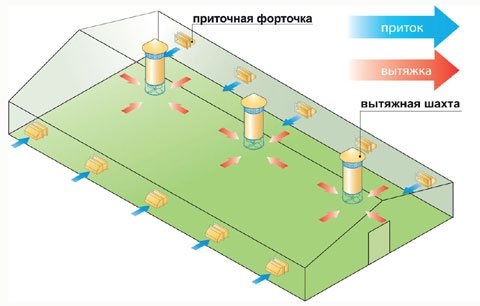

To close access to raindrops, an umbrella is mounted above the outlet of the box. As a rule, in structures of natural air exchange, a deflector is mounted directly at the mouth. With gusts of wind, a rarefaction is created here, which contributes to an increase in traction. But first of all, of course, the deflector does not allow the air flow to "topple over" in the box. When calculating the system, the vacuum generated by the wind is not taken into account.
Variants with artificial air exchange, which help to remove aggressive air impurities of the first and second classes, work in a slightly different way: polluted air is thrown out to a rather significant height. Such an ejection is also called a flare.
Height ↑


When placing an exhaust duct on the roof of a building, the smallest permissible distance between it and the air intake of the supply system must be taken into account. According to SNiP:
- horizontally it is equal to ten meters,
- vertically, respectively, six.
The height of the ventilation shaft above the roof is determined according to the following conditions:
- when it is located near the ridge, the mouth, that is, the hood hole should be higher than the ridge, at least half a meter;
- when located at a distance of one and a half to three meters from the ridge, the hole is flush with the ridge;
- for distances over three meters, the hole is brought out along the side of an angle of 10⁰ to the horizon with the apex on the ridge.


In public catering and food stores, according to SanPiN, the height of the mine above the roof should not be less than 1 m. Thus, this indicator is a variable value that varies depending on the specific project.
The height of the mouth above the roof for a standard design is usually chosen equal to 1 m, in the case of a flare discharge - at least 2 m above the highest point of the roof. For emergency - the mine is raised to a height of at least 3 m from the ground.
Material ↑
In residential and public buildings with a system of combined ducts for extraction, lightweight concrete, brick, galvanized boards are most often used. The trunk of the passage from the inside is preliminarily covered with felt, which is moistened with a solution of clay and plastered on the outside. In industrial buildings, the exhaust structure is mainly made of sheet steel.
Fire safety ↑
When organizing ventilation of a building, all rooms and floors are connected to each other by a network of channels and air ducts, which in itself is dangerous from the point of view of fire safety. Therefore, these elements themselves and the gaskets between them are made of materials that meet SNiP, according to which explosion and fire safety is ensured. In particular, the shaft is separated from the air duct by a partition made of non-combustible and moisture-resistant material.
Why does a private house need ventilation
Structurally, residential buildings are closed spaces, reliably isolated from the external environment. Walls, doors and windows protect the premises from precipitation, warm and cold air, dust, animals and insects.


However, this kind of isolation from the outside world has the following side effects:
- When people breathe, carbon dioxide is formed, which in high concentrations is harmful to health. If you don't get rid of it, then feeling unwell is the least of possible troubles.
- Constant dampness. The vital activity of people (washing, wet cleaning, taking water procedures, cooking) is inextricably linked with the formation of high humidity.
- Accumulation of carbon monoxide from the operation of heating boilers. And this is a real threat to life.
Incorrect calculation of the removal of waste air masses from the room leads to complex and sometimes insoluble issues.
Efficient traction process
A certain difference appears if the air temperature indicators outside the room and inside it have different indicators. And the greater this difference, the more forcefully the air masses rise upward from the room. If it is warm enough outside, then the draft decreases, and the effectiveness of ventilation itself decreases. In addition, the parameters of the pipe section and the dimensions of the ventilation ducts affect the intensity of the draft.
The process of pulling from the inside out
It is worth noting that the design and carrying out of the corresponding calculations for the ventilation system must be done at the initial stages. It is almost impossible to make corrections in the course of work. Experts say that rooms that are approximately at the same level must have the same length of ventilation channels, otherwise the efficiency of the entire system can drop dramatically.
There are the following features for choosing the parameters of the ventilation pipe:
- the channel section must be at least 16 cm 2 if the pipe is made of stainless steel;
- the side of the canal should be at least 10 cm, and the most common option is 14 cm. In this case, its length will be about 3 m;
- if it is impossible to create the same length of channels, ventilation grilles are used for all rooms of the building.
If the calculations are carried out correctly, then you will see why a ventilation pipe is needed in every house.It will supply fresh air and remove polluted air up to three times in just one hour.
Regardless of the type of ventilation systems, special transfer grilles are installed for the unimpeded movement of air masses throughout the building. With the correct organization of the air flow, the dirtiest room will be ventilated last. In accordance with this principle, the hood is installed in the toilet or in the kitchen.
Ventilation in windy weather
What will happen if done poorly
Without delving into the essence of ventilation technology, many believe that it is enough to install an air conditioner and the problem will be solved. However, this unit drives the air inside the room without refreshing it at all.
The absence or incorrect calculation of the length of the duct is fraught with the following consequences:
- In the absence of an inflow of oxygenated fresh air, the residents of the house will suffer from headaches. Their sleep will be disturbed, their immunity will weaken, their working capacity will decrease.
- Due to constant dampness, fungus and mold will develop on walls, furniture, things and products. Pathogenic microflora is extremely hazardous to health and destroys interior elements.
- The aesthetic component suffers. Excess moisture accumulates on walls and windows. Perspiration forms on the glasses, constantly flowing down to the windowsills.
According to the current SNPs, it is recommended to install ventilation in rooms that do not have windows. These include bathrooms, toilets, storage rooms and kitchens, regardless of their architecture.
Types of ventilation
According to fire safety requirements, air conditioning systems must be installed in all houses equipped with boilers operating on any type of fuel.
Ventilation can be natural or forced. Let's briefly dwell on the features of each.
Natural
As a rule, it is installed in tall buildings, where the difference in the height of the inlet (windows) to the end point of the ventilation outlet (pipe cut) is quite significant. Air outflow occurs due to the difference in atmospheric pressure at different levels of the building. The flow rate depends on the strength of the wind, it is regulated by changing the parameters of the inlet and outlet openings.
Mechanical
Assumes the installation of one or more fans. It is used for furnishing interiors where there is no natural air flow to create sufficient draft. In some cases, mechanical air conditioning is done with a slight difference in air temperature inside and outside the building.
To create a comfortable microclimate, its forced evacuation is organized using window or wall fans.
The power of the products is selected individually.
Types of ventilation systems
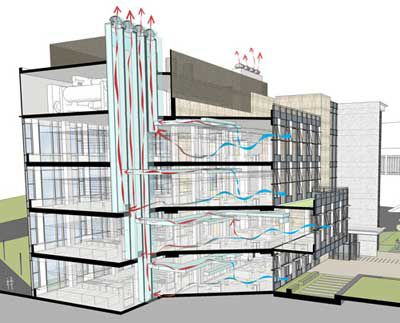

ventilation of a multi-storey building
The design of the ventilation elements depends on the selected type of system. Moreover, any of them contains a mandatory set: air ducts, ventilation shaft, umbrella.
The following types of air exchange systems are used in apartment buildings:
- Air exchange is natural. Traction is caused by the difference in air indicators outside and inside the house. Air is supplied through slightly open windows or vents.
- Combined ventilation. Air supply or exhaust is provided by mechanical devices.
- Mechanical ventilation. The movement of air in and out of apartments is carried out only with the help of mechanisms.
With natural air exchange in a multi-storey building, ventilation shafts are an indispensable component of the system. Forced ventilation of low-rise buildings can only consist of air ducts that extract air from each individual apartment.
How to correctly determine the height of the pipe
This factor is decisive when designing a ventilation system. It is necessary to carry out the necessary calculations even at the stage of drawing up drawings of engineering communications of the future house.During the construction process or after its completion, it will be extremely difficult or impossible to make adjustments and changes.
What influences
Several factors affect the overall height of the exhaust duct.


The most significant of them are as follows:
- temperature drops in the room and outside the window;
- the presence of a nearby chimney from the heating boiler;
- prevailing wind direction and strength;
- the degree of resistance of air friction against the walls of the pipeline;
- exhaust system configuration, presence and number of corners.
So, in the summer, the thrust is significantly reduced, since the temperature inside and outside the house is almost the same. However, an excessively high chimney can be dangerous in terms of falling in strong gusts of wind.
Roof structure
The roofs of residential buildings have different shapes. In snowless regions of the country with little rainfall, houses are covered with a flat roof, as it is easier, faster and cheaper. The height of the ventilation duct does not really matter here. The main thing is that sufficient traction was provided, for this you need 50-60 cm of elevation when the pipe is located next to the roof ridge or parapet.
In cases of arranging buildings with pitched roofs, it is necessary to take into account the ratio between their highest point and the cut of the ventilation duct.
If the distance to the ridge is less than 150 cm, then the pipe must be raised above the roof by 40-50 cm. At a greater distance, it must be raised above the ridge by at least 100 cm.This will ensure the capture of the outgoing air by the wind and create good traction.
Ventilation pipe installation requirements
Compliance with the requirements that are put forward for the installation of a ventilation unit is a guarantee that there will be no mold or high humidity in the house. One of the tasks of the roof is to protect the premises from the penetration of precipitation, as well as maintain the optimal temperature regime, which is comfortable for the residents of the house.
The ventilation pipe is a through hole through the roof. That is, in order to conduct ventilation through the roof, it is necessary to make a through hole, which will open access to precipitation into the house.


The ventilation pipe can look quite stylish, the variety of materials, shapes of these products allows not to hide this attribute, but to display it
That is why the ventilation entry point needs additional insulation from precipitation and melt water. In addition, it must be protected against condensation. The latter arises from the high difference in temperature between that which was achieved indoors and that outside. Thus, the main requirement for a ventilation pipe is its complete tightness and thermal insulation.
Also, it is important to ensure that precipitation flows freely from the roof, that is, the ventilation pipe does not interfere with this. Not an easy task. On the one hand, nothing should interfere with the flow of fresh air into the room. On the other hand, the pipe should only allow air to pass through, but prevent the penetration of precipitation, insects, etc.
To solve the listed problems, you can install special gangways. With their help, uninterrupted transportation of air flows is ensured, without significant interference with the functionality of the roof.
The main requirements for the installation of the ventilation shaft are as follows:
- protection from the so-called "cold bridges" - to prevent the formation of places through which heat can escape from the room;
- sealing;
- a mandatory requirement is a tight fit of the ventilation pipe to the roof;
- installation of additional protective elements - after sealing, the joints are covered with additional structures (they perform both a decorative and a practical function).
If there are several exits on the roof, for example, a chimney, a TV antenna or a satellite, then you can create one common shaft through which they will exit.
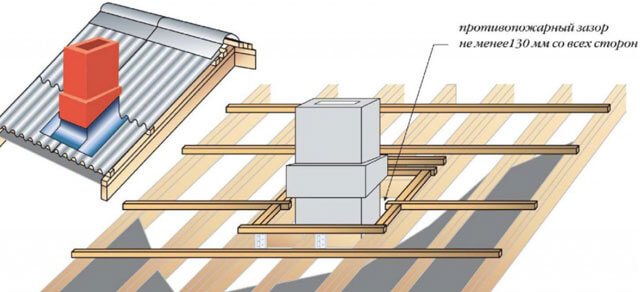

The roof shaft is mounted in order to hide the abundance of exits that lead through the roof and protect them from precipitation
A ventilation hole can be added to all these outlets, that is, the roof will be connected to the ventilation shaft through a special outlet. The mine is constructed of metal or wood, it is advisable to think about the method of removing ventilation and other communications at the time of roof construction.
It is worth remembering that for the perfect abutment of the air ducts to a metal roof or a roof made of any other material, it is better to make the ventilation pipe square or rectangular.
In this case, to ensure the correct abutment of the duct, a square pad is used. It is put on top of the pipe and provides its protection. The space formed between the ventilation pipe and the pad is filled with sand or any other non-combustible mixture.


In order to give the roof a more aesthetic look, you can build a common box in which all the pipes will be hidden.
To protect the room from moisture penetration, a sealant is used for the joints, and a deflector is installed in the upper part of the ventilation pipe.
Additional requirements are set for the length of the ventilation pipe; in the absence of draft, fans can be mounted in it.
The height of the pipe must be at least as high as the chimney. In addition, the distance between the joint and the deflector must be sufficient for the free movement of air masses.


In order to avoid the appearance of condensation or improper drainage of precipitation, it is important to correctly install the ventilation pipe, observing the requirements for its height and location on the roof
The ventilation unit can be positioned along the roof slope. It is in this case that the pipe will not create obstacles for snow melting or free flow of precipitation from the roof.
The most ideal place is the ridge, like the top of the roof. This is the only way to ensure maximum draft, without installing additional fans.
Calculation of the duct diameter and duct height
To make the correct calculation of the diameter of the duct, you can use the help of a specialist, study regulatory documents or use an electronic calculator.
Standards
The rules for arranging ventilation ducts are set out in SNiP 2.04.05–86.
The main ones are as follows:
- ventilation ducts from the kitchen and the heating boiler should be cut into the ventilation system last;
- the strength and height of the pipes must correspond to the wind load;
- The air duct passing through the walls and roof of the cottage must be airtight and resistant to corrosion.
To reduce the flow rate in the ducts, it is necessary to install ventilation grilles.
The inflow must be at least 3 m³ / h, regardless of the number of people in the room.
According to the table
The calculation according to the table is used in cases where the owner of the house has an extensive selection of building materials and has accurate data regarding the parameters of the future structure. It is only necessary to compare the diameter or area of the duct with the volume of the room. For more complex calculations, the shape of the line, its roughness and temperature indicators are taken into account. You can use the table:
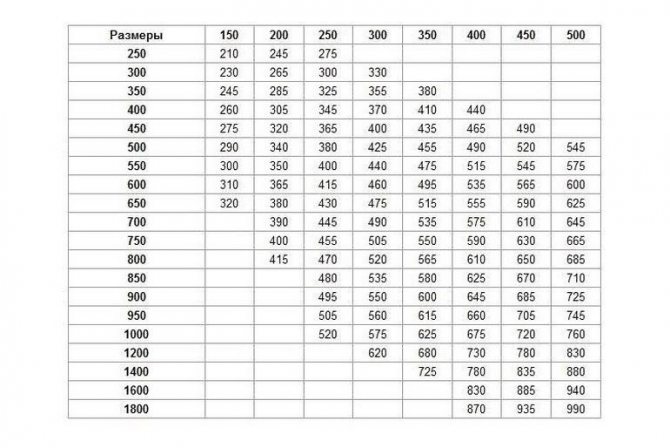

Calculator
The electronic calculator on the website https://ventkam.ru is a real godsend for craftsmen who equip ventilation in the house with their own hands. Data counting is fast and accurate. All you need is to take measurements and enter the resulting numbers into the cells.
The calculation accuracy with the calculator varies within 80-90%.
Nuances
Even properly and soundly built ventilation needs regular maintenance. This is necessary to restore the geometry and cross-sectional area of the ventilation ducts.
The main parameters affecting the height of the ventilation ducts above the roof


The height of the pipe relative to the roof
To create the correct microclimate, the house must be equipped with an air circulation system.The correct height of the ventilation shaft above the roof will help to ensure correct operation. The calculation methods depend on the type of ventilation. The following factors affect the size of the outer part of the ventilation ducts.
- Ventilation duct shape. A combination of square and round is often carried out.
- Air flow volume. It is carried out through a window, a special supply valve built into the wall or attached.
- The length of the chimney varies from the shape of the roof, the location of the ridge, the chimney. To calculate it, the multiplicity factor is used based on the rules of SNiP.
- Requirements of rules and regulations for air ducts.
When constructing ventilation ducts, the owner of the premises is obliged to notify the operating company.
Skate dimensions
When the air duct is located near the ridge - no further than 1.5 m, the outer height of the pipe should not exceed 50 cm.If the ventilation channel is located at a distance of 1.5 to 3 m to the edge of the roof, it should be flush with the ridge of the house. When the ventilation channel is referred to more than 3 m, its height decreases in relation to the ridge of the house by no more than 10 degrees.
Roof structure


Location of ventilation pipes on a flat roof
The height of the ventilation pipe above the roof without a slope must be at least 50 cm. The ventilation pipe must withstand squally wind and a 10-point storm. For this, its weight must be at least 50 kg / sq. m. surface.
Cross section
In the absence of forced removal mechanisms, a round pipe is the best option. This type of duct is stronger, more airtight, more aerodynamic in comparison with a rectangular or square section.
Before calculating the diameter, the following parameters are set:
- the volume of each of the ventilated rooms;
- air volume for normal circulation for each room.
The pipe diameter is calculated from the diagram after determining the total volume of the rooms. In this case, the speed of the current in the central line should not exceed 5 m / s, and in the side lines - 3 m / s.
Ventilation
On the outside of the wall, the ventilation duct is not installed, since condensation forms and the flow rate decreases. The inflow volume should be 3 m³ / h per 1 sq. m., regardless of the number of people. According to sanitary standards, 20 m³ / h is sufficient for temporarily staying, 60 m³ / h for permanent residents. In utility rooms - from 180 m³ / h.
Fire safety rules
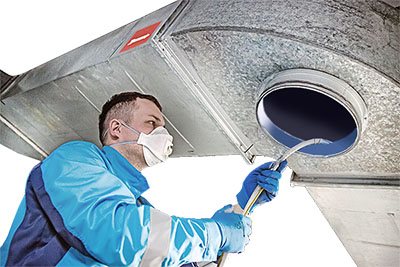

Ventilation ducts must be checked and cleaned regularly
SNiP rules provide for checking, cleaning chimneys and ventilation pipes as follows:
- before the heating season;
- Once every 3 months or more often for combined and brick air ducts;
- Once a year or more often for asbestos-cement pipes, ceramic and heat-resistant concrete products.
The initial inspection evaluates not only the materials of manufacture. The absence of blockages, irregularities in pipes, the presence of separate smoke and ventilation outlets is analyzed. SNiP rules prohibit the removal of combustion products into the ventilation channels. Self-cleaning is allowed after passing the briefing with the receipt of the paper on the completion of training.
Summary
The video in this article will help you understand the principle of calculating the length and diameter for the chimney and ventilation. But I still believe that without certain knowledge in the field of ventilation and heating, it is difficult to independently carry out all measurements correctly, it is better to turn to specialists, this service is inexpensive.
Of course, you can do everything yourself, but there is a risk that the controlling organizations of the gas industry simply will not accept the facility into operation and everything will have to be redone, which will cost much more. Ask questions - I will be glad to discuss this topic in the comments.
